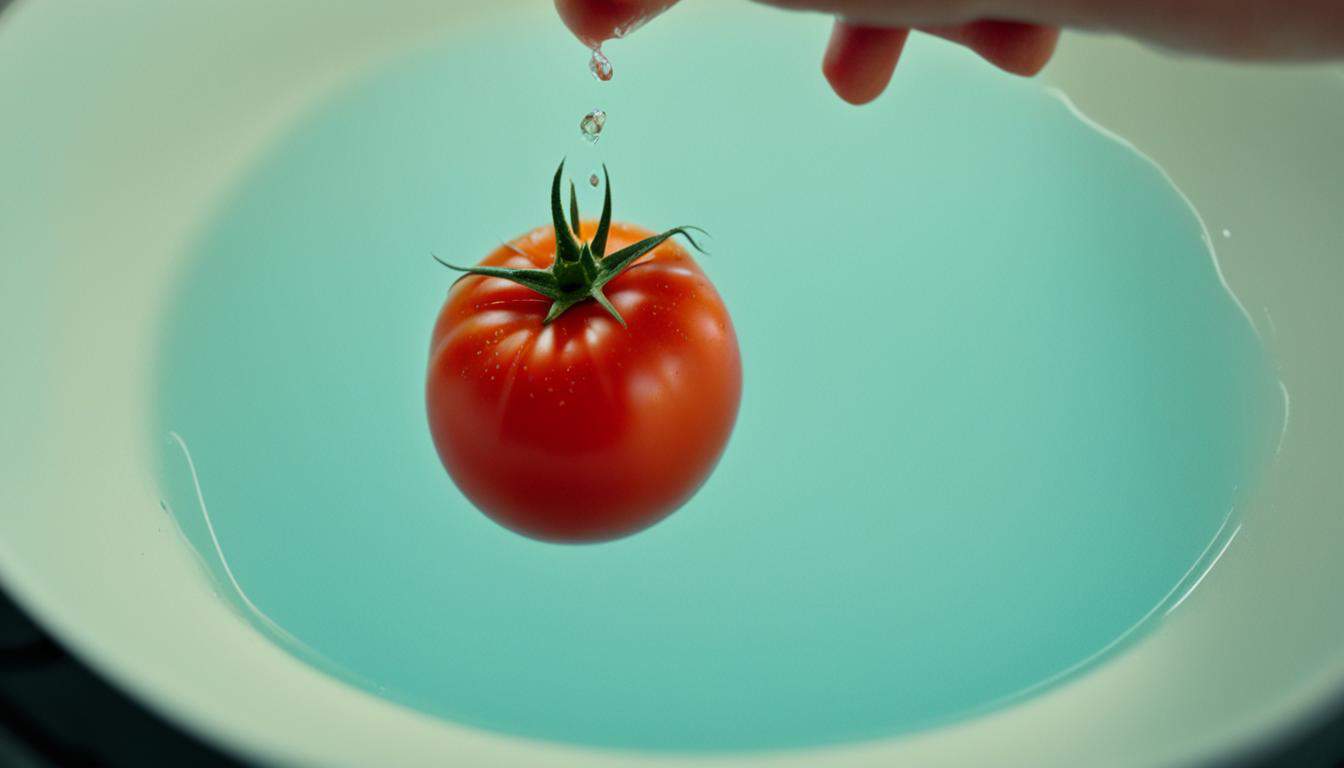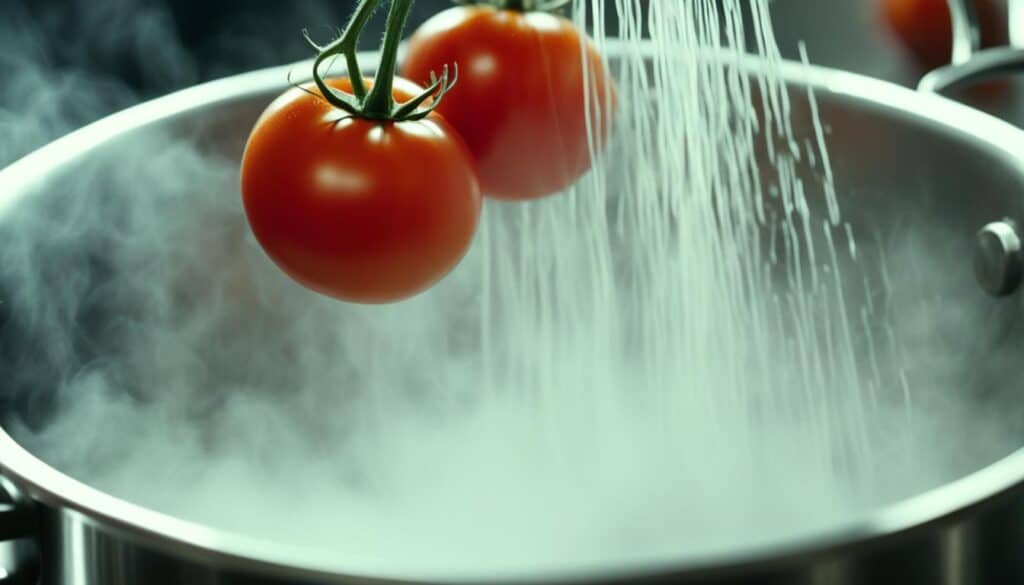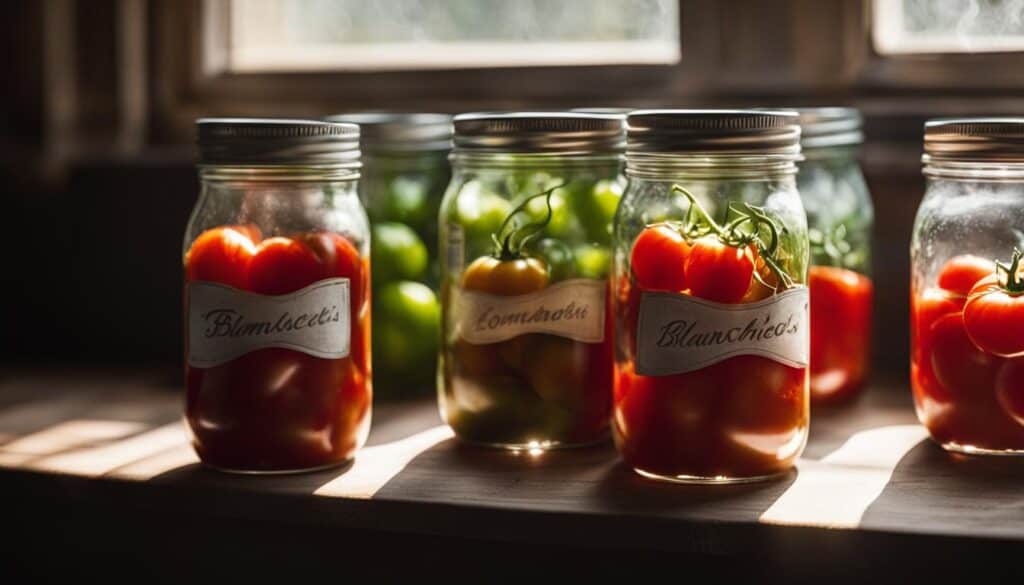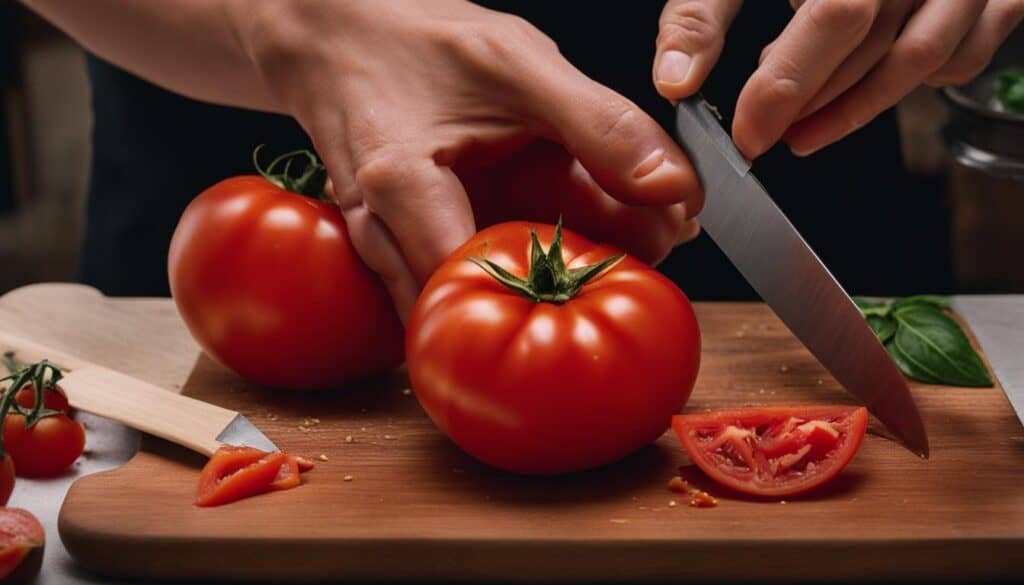Blanching tomatoes is a simple technique that can add so much flavor to your recipes. Whether you’re making sauces, soups, stews, or preserving tomatoes, blanching is an essential skill to have. By blanching tomatoes, you can easily remove the skin, achieve smooth sauces, and preserve the fruit for future use. In this easy guide, I’ll walk you through the step-by-step process of blanching tomatoes at home.
Key Takeaways:
- Blanching tomatoes enhances the flavor of your recipes.
- It is a crucial step for achieving smooth sauces and soups.
- Blanching also helps in preserving tomatoes for future use.
- The process involves boiling the tomatoes briefly and then cooling them in an ice bath.
- By blanching tomatoes, you can easily remove the skin without damaging the fruit.
Why Blanch Tomatoes?
Blanching tomatoes is an essential step in many recipes, and for good reason. It offers several benefits that contribute to achieving delicious and smooth sauces, soups, and stews. Let’s explore why blanching tomatoes is a game-changer in the kitchen.
Removing Tomato Skin: One of the main reasons to blanch tomatoes is to easily and efficiently remove the skin. The process involves briefly immersing the tomatoes in boiling water, which causes the skin to loosen. This allows you to effortlessly peel off the skin without damaging the delicate flesh of the tomatoes. With blanched tomatoes, you can enjoy the smooth texture of your dishes without any unwanted tomato skin.
Achieving Smooth Sauces: When making sauces, such as marinara or tomato puree, blanching tomatoes ensures a silky smooth consistency. By removing the skin, you eliminate any potential bitterness or tough texture that the skin may add to the sauce. This results in a velvety sauce that effortlessly coats your pasta or enhances the flavors of other dishes.
Preserving Tomatoes: Blanching is also a necessary step for preserving tomatoes. Whether you plan to can or freeze them, blanching helps maintain the quality and flavor of the tomatoes over time. By removing the skin before preserving, you prevent it from becoming tough or chewy during storage.
Easy Tomato Peeling: Peeling tomatoes can be quite challenging without blanching. The skin tends to cling stubbornly to the flesh, making it difficult to remove. Blanching solves this problem by loosening the skin, allowing you to peel tomatoes with ease. This means you spend less time struggling with peeling and more time enjoying your tomato-based creations.
Blanching tomatoes truly revolutionizes the way you work with this versatile fruit. It simplifies the preparation process, enhances the texture and flavor of your dishes, and ensures successful preservation. So, the next time you’re working with tomatoes, don’t skip the blanching step!
Step-by-Step Guide to Blanching Tomatoes
Blanching tomatoes is a simple and effective technique for easily removing the skin. Follow this step-by-step guide to blanch tomatoes at home and elevate your cooking:
- Bring a pot of water to a rolling boil.
- Score the tomatoes: Using a sharp knife, gently score a shallow “X” on the bottom of each tomato. This helps the skin peel off easily.
- Prepare an ice bath: Fill a large bowl with cold water and ice cubes, creating a bath to rapidly cool the tomatoes.
- Blanch the tomatoes: Carefully lower the scored tomatoes into the boiling water using a slotted spoon. Leave them in the boiling water for about 30-60 seconds.
- Transfer to the ice bath: Immediately remove the tomatoes from the boiling water and transfer them to the ice bath. This halts the cooking process and ensures the tomatoes cool quickly.
- Peel the tomatoes: Once the tomatoes are cooled, remove them from the ice bath. The skin should now be loose and easy to peel. Use your hands or a knife to gently remove the skin.
Blanching tomatoes allows for effortless skin removal, giving you smooth sauces and preserving the freshness of your tomatoes. Create flavorful dishes by mastering this blanching technique.
Tips for Successful Blanching:
- Choose ripe tomatoes for easier peeling.
- Ensure the water is at a rolling boil before adding the tomatoes.
- Cool the tomatoes in the ice bath immediately after blanching to prevent them from becoming mushy.
- Gently handle the blanched tomatoes using a slotted spoon to avoid damaging the fruit.
| Advantages of Blanching Tomatoes | Disadvantages of Blanching Tomatoes |
|---|---|
| Easy and efficient peeling method | Potential risk of overcooking the tomatoes |
| Smooth and consistent texture for sauces and soups | Requires additional equipment such as a pot and ice bath |
| Preserves the freshness and flavor of the tomatoes |
Tips for Blanching Tomatoes
To ensure successful blanching, here are some helpful tips:
- Use ripe tomatoes: Opt for fully ripe tomatoes as they are easier to peel, ensuring a smooth blanching process.
- Score the tomatoes: Before blanching, score the bottom of each tomato with a shallow “X.” This technique allows the boiling water to penetrate the skin and make peeling easier.
- Boil the water first: Bring a pot of water to a rolling boil before adding the tomatoes. This ensures that the water remains at the proper temperature throughout the blanching process.
- Cool in an ice bath: After blanching the tomatoes, immediately transfer them to an ice bath to halt the cooking process. This prevents them from becoming mushy and helps retain their texture.
- Handle gently: When removing the blanched tomatoes from the pot, use a slotted spoon to gently lift them. This reduces the risk of damaging the tomatoes and preserves their shape.
By following these tips, you’ll achieve perfectly blanched tomatoes that are easy to peel and ready to be used in your favorite recipes.
Expert Tip:
“Scoring the tomatoes before blanching is a game-changer. It allows the hot water to penetrate the skin and makes peeling a breeze.” – Chef Maria Sanchez
Storing Blanched Tomatoes
Once you’ve blanched and peeled your tomatoes, it’s important to store them properly to retain their flavor and freshness. There are several storage options to choose from, depending on your needs and preferences.
Refrigerating Blanched Tomatoes
If you plan to use your blanched tomatoes within a few days, refrigeration is a convenient option. Simply place the peeled tomatoes in an airtight container and store them in the refrigerator. This will help maintain their quality for up to 2-3 days. Remember to label the container with the date of blanching to keep track of freshness.
Freezing Blanched Tomatoes
If you won’t be using your blanched tomatoes immediately, freezing them is an excellent way to preserve their flavor for future use. Before freezing, make sure the tomatoes are completely cooled down. Then, arrange them in a single layer on a baking sheet and place them in the freezer until frozen solid. Once frozen, transfer the tomatoes to a freezer-safe bag or container, making sure to remove any excess air. Frozen blanched tomatoes can be stored for up to 6 months, giving you the flexibility to enjoy them whenever you want.
Canning Blanched Tomatoes
Another popular method of preserving blanched tomatoes is through canning. Canning allows you to enjoy the taste of summer tomatoes all year round. It involves sealing blanched tomatoes in jars using a boiling water bath or pressure canner. Follow the USDA canning guidelines for safety and proper processing times. Canned blanched tomatoes can be stored in a cool, dark place for up to 1 year.
Remember, whether you choose to refrigerate, freeze, or can your blanched tomatoes, it’s essential to handle them with care and maintain proper food safety practices to ensure maximum quality and flavor.
| Storage Method | Duration |
|---|---|
| Refrigeration | Up to 2-3 days |
| Freezing | Up to 6 months |
| Canning | Up to 1 year |
Recipe Ideas with Blanching Tomatoes
Now that you’ve blanched your tomatoes, it’s time to get creative in the kitchen! Here are some delicious recipe ideas to make the most of your blanched tomatoes:
1. Tomato Sauces
Blanched tomatoes are perfect for creating flavorful tomato sauces. Whether you’re making a classic marinara, a spicy arrabbiata, or a creamy vodka sauce, the blanched tomatoes will provide a smooth and rich base. Simply blend or crush the blanched tomatoes and simmer with your choice of herbs, spices, and seasonings.
2. Soups and Stews
Add depth and freshness to your soups and stews with blanched tomatoes. They can be the star ingredient in a comforting tomato soup, a hearty beef stew, or a zesty gazpacho. The blanched tomatoes will infuse your dishes with a vibrant and robust flavor.
3. Salsas
Blanched tomatoes are the secret to a perfect salsa. Whether you prefer a mild chunky salsa or a fiery pico de gallo, blanching the tomatoes will ensure easy peeling and a smooth texture. Chop the blanched tomatoes, combine with onions, peppers, cilantro, lime juice, and spices for a refreshing and tangy salsa.
4. Bruschetta and Salads
Top your crispy bruschetta slices with blanched tomatoes for a burst of freshness. Combine diced blanched tomatoes with garlic, basil, olive oil, and balsamic vinegar for a delicious topping. You can also use blanched tomatoes in colorful salads, alongside mozzarella, fresh herbs, and a drizzle of olive oil.
“Blanching tomatoes opens up a world of culinary possibilities.”
So, whether you’re whipping up a classic Italian dish or experimenting with international flavors, using blanched tomatoes will take your recipes to the next level. Let your creativity flow in the kitchen and enjoy the vibrant flavors of dishes made with blanched tomatoes!
| Recipe | Description |
|---|---|
| Spaghetti with Fresh Tomato Sauce | A simple and light pasta dish with blanched tomatoes, garlic, olive oil, and fresh herbs. |
| Gazpacho | A refreshing cold soup made with blanched tomatoes, cucumbers, bell peppers, onions, and garlic. |
| Caprese Salad | A classic Italian salad with blanched tomatoes, fresh mozzarella, basil, and a drizzle of balsamic glaze. |
| Creamy Tomato Basil Soup | A comforting soup made with blanched tomatoes, cream, fresh basil, and a touch of Parmesan cheese. |
How to Peel Tomatoes without Blanching
Blanching is the traditional method for peeling tomatoes, but there are alternative methods as well. If you prefer not to blanch, you can try using a knife to peel the tomatoes. However, blanching is the most efficient and effective way to achieve perfectly peeled tomatoes.
If you want to avoid blanching, you can follow these steps to peel tomatoes using a knife:
- Start by scoring the bottom of each tomato with a shallow “X”. This will help the skin loosen.
- Boil a pot of water.
- Lower the tomatoes into the boiling water for about 10-15 seconds. You will notice the skin starting to peel back at the scored “X”.
- Using a slotted spoon, transfer the tomatoes to a bowl of ice water to cool them quickly and stop the cooking process.
- Once cooled, you can easily peel the tomatoes by gently pulling the skin back from the scored “X”.
While this method can be effective, it requires more time and effort compared to blanching. It may also result in less evenly peeled tomatoes, as it can be challenging to remove all the skin without damaging the flesh.
For the best results, I recommend sticking to blanching as the preferred method for peeling tomatoes. It is quick, efficient, and ensures that you achieve perfectly peeled tomatoes every time.
Note: The image above is for illustrative purposes only and does not depict the alternative method described in this section.
Pros and Cons of Blanching Tomatoes
Blanching tomatoes has its own set of advantages and disadvantages that are worth considering. Understanding the pros and cons can help you make an informed decision when deciding whether to blanch your tomatoes.
Advantages of Blanching Tomatoes
- Easy Peeling: Blanching tomatoes makes the peeling process much easier. The brief exposure to hot water allows the skin to loosen, making it effortless to remove.
- Smooth Sauces: Blanching tomatoes before using them in sauces helps achieve a smoother texture. The removed skin and seeds ensure a velvety consistency, perfect for a variety of dishes.
- Preservation: Blanching is a crucial step in preserving tomatoes. By blanching and freezing or canning them, you can prolong their shelf life and enjoy the taste of summer all year round.
Disadvantages of Blanching Tomatoes
- Risk of Overcooking: One of the potential downsides of blanching tomatoes is the risk of overcooking them. With the short blanching time, it’s essential to monitor the tomatoes closely to prevent them from becoming too soft or losing their flavor.
- Extra Equipment: Blanching tomatoes requires a few additional tools, including a pot for boiling water and an ice bath for cooling the tomatoes. While these are relatively common kitchen items, it’s worth considering if you have the necessary equipment for the blanching process.
Despite the disadvantages, the benefits of blanching tomatoes, such as easy peeling, smooth sauces, and preservation, make it a popular technique among home cooks and professional chefs alike.
“Blanching tomatoes offers a convenient way to remove the skin and seeds, resulting in a smoother texture and enhanced flavor in sauces and stews.” – Chef Julia Thompson
Now that you’re aware of the pros and cons of blanching tomatoes, you can make a well-informed decision based on your culinary preferences and requirements. Experiment with blanching to experience the advantages it offers while keeping in mind the potential challenges it may present.
Troubleshooting Blanching Tomatoes
Sometimes, issues may arise during the blanching process. Common problems include tomatoes not peeling easily or becoming mushy. To troubleshoot these issues, here are some solutions:
Problem: Tomatoes not peeling easily
Issue: The tomato skin is not coming off smoothly, making it difficult to peel.
Solution: Ensure that you are using ripe tomatoes. Ripe tomatoes have softer skin, which makes them easier to peel. Additionally, make sure you are blanching the tomatoes for the appropriate time. Under-blanching can result in stubborn skin, while over-blanching can cause the tomatoes to become mushy.
Problem: Tomatoes becoming mushy
Issue: The tomatoes become soft and lose their texture during the blanching process.
Solution: Make sure you are blanching the tomatoes for the right amount of time. Over-blanching can cause the tomatoes to become mushy. The ideal blanching time may vary depending on the size and ripeness of the tomatoes, so it’s important to monitor them closely. Also, ensure that you cool the tomatoes in an ice bath immediately after blanching to stop the cooking process and preserve their texture.
By following these troubleshooting tips, you can overcome common issues that may arise when blanching tomatoes. Enjoy the smooth, peeled tomatoes in your recipes!
| Problem | Solution |
|---|---|
| Tomatoes not peeling easily | Ensure ripe tomatoes and blanch for the appropriate time |
| Tomatoes becoming mushy | Blanch for the right amount of time and cool in an ice bath |
Conclusion
After learning about the process of blanching tomatoes, it is clear that this technique is a game-changer for any home cook. Blanching tomatoes not only gives you smooth and flavorful sauces, soups, and stews, but it also allows you to preserve the delicious taste of tomatoes for future use.
By following the step-by-step guide and implementing the helpful tips provided in this article, you can easily master the art of blanching tomatoes at home. From scoring the tomatoes to dropping them into a boiling water bath and then swiftly transferring them into an ice bath, the process is simple and effective.
Blanching tomatoes offers numerous advantages, such as easy peeling, achieving smooth sauces, and preserving the vibrant flavors of tomatoes. While there may be alternative methods for peeling tomatoes, blanching remains the most efficient and reliable option.
So, whether you’re making a batch of tomato sauce or preparing tomatoes for canning or freezing, don’t forget to blanch them first. This technique will ensure that your recipes are bursting with the taste of perfectly blanched tomatoes, elevating your culinary creations to new heights.










Leave a Reply